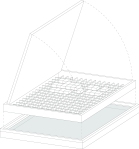For this week’s assignment I will make a printing press.
Above: an original Gutenberg Press (ca. 1450)
This assignment also incorporates an even earlier written format, that of Roman wax tablets (below):
Flexible Formwork Criteria:
Formwork must be adjustable
Formwork must be reusable
Machines to be used:
Waterjet cutter
CNC router
Materials:
Frame: metal/wood
Printed material: rubber, concrete, plaster, and/or wax
Step 1: Build setting bed
A shallow pan is constructed out of wood. This is the bed into which the printed material is to be poured/set. The depth of the printed material is to be no greater than 1/2″
Exterior dimensions of setting bed to be 8.5×11″
Step 2: Movable type machine
A grid is fabricated with the CNC machine/waterjet cutter. Corresponding letter/number type pieces are also fabricated to slot inside the grid. The pieces will protrude from the bottom of the grid (and into the print material) approx. 1/16″.
The grid rests within a box with a hinged lid. The lid, when shut, ensures that the type pieces do not “float” on the print material, but instead protrude into it.
Step 3: Print!




